If you buy through our links, we may earn an affiliate commission. This supports our mission to get more people active and outside.Learn about Outside Online's affiliate link policy
The Best Backpacking Sleeping Pads (2025)
Sleeping pads might seem like glorified pool toys, but modern options are packed full of impressive tech. From hollowed-out cores and reflective coatings to graduated baffles that act like guardrails to keep you centered on the pad, these hyper-engineered pieces of gear are all but guaranteed to win the war on backcountry insomnia.
At a Glance
Best Overall: Therm-a-Rest NeoAir Xlite NXT ($210)
For Ultralight Side-Sleepers: NEMO Tensor All-Season ($200)
Best Features: Sea to Summit Ether Light XR Insulated Air ($189-259)
Best Value: Big Agnes Rapide SL Insulated ($160)
Lightest Inflatable: NEMO Tensor Elite ($200)
Most Comfortable: Therm-a-Rest NeoLoft ($240-260)
Plushest Summer Pad: Exped 3R Mummy ($160)
Best Closed Cell Foam: Ozark Trail Camping Pad ($15)
Best Backup Pad: Outdoor Vitals 1/8-Inch Pad ($20)
Best Inflatable Under $100: Decathlon Forclaz MT500 ($80)
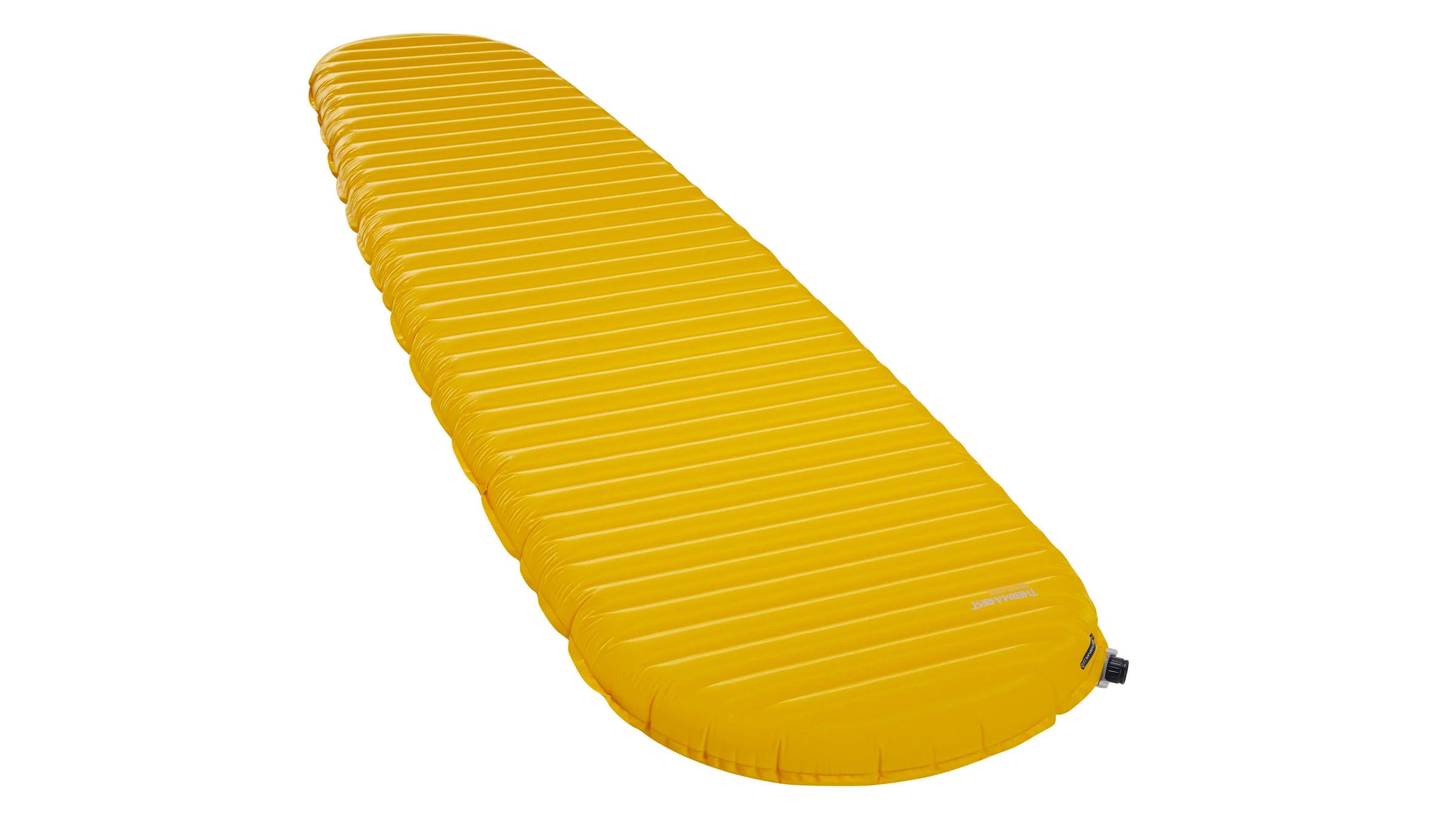
Best Overall
Therm-a-Rest NeoAir Xlite NXT ($210)
Weight: 13 oz (regular)
Sizes: Regular Short, Regular, Regular Wide, Large
R-Value: 4.5
Lab-Tested Puncture Resistance (1-5): 3
Pros and Cons
+ Extremely light
+ Packable
+ Warm
𑂾Horizontal baffling uncomfortable for some
𑂾Expensive
Across both winter and summer testing, Therm-a-Rest’s flagship NeoAir pads sit comfortably atop the list. And the three-season variant, the NeoAir Xlite NXT, deserves a heap of praise: For sleepers who aren’t picky about the slippery horizontal baffles, you won’t find a much lighter pad with this level of warmth.
Packed, the Xlite NXT is about the same size as an overstuffed Chipotle burrito. Within this ultra-compact package is a universe of technology centered around a “triangular core matrix” construction, essentially two layers of baffles stacked on top of each other, then bonded, edge-to-edge, to a middle barrier. Each of these individual cells slows convective heat loss—with help from a reflective film—and offers a uniform sleeping structure. In combination with three inches of height, the pad’s R-value hits a true shoulder season rating of 4.5.
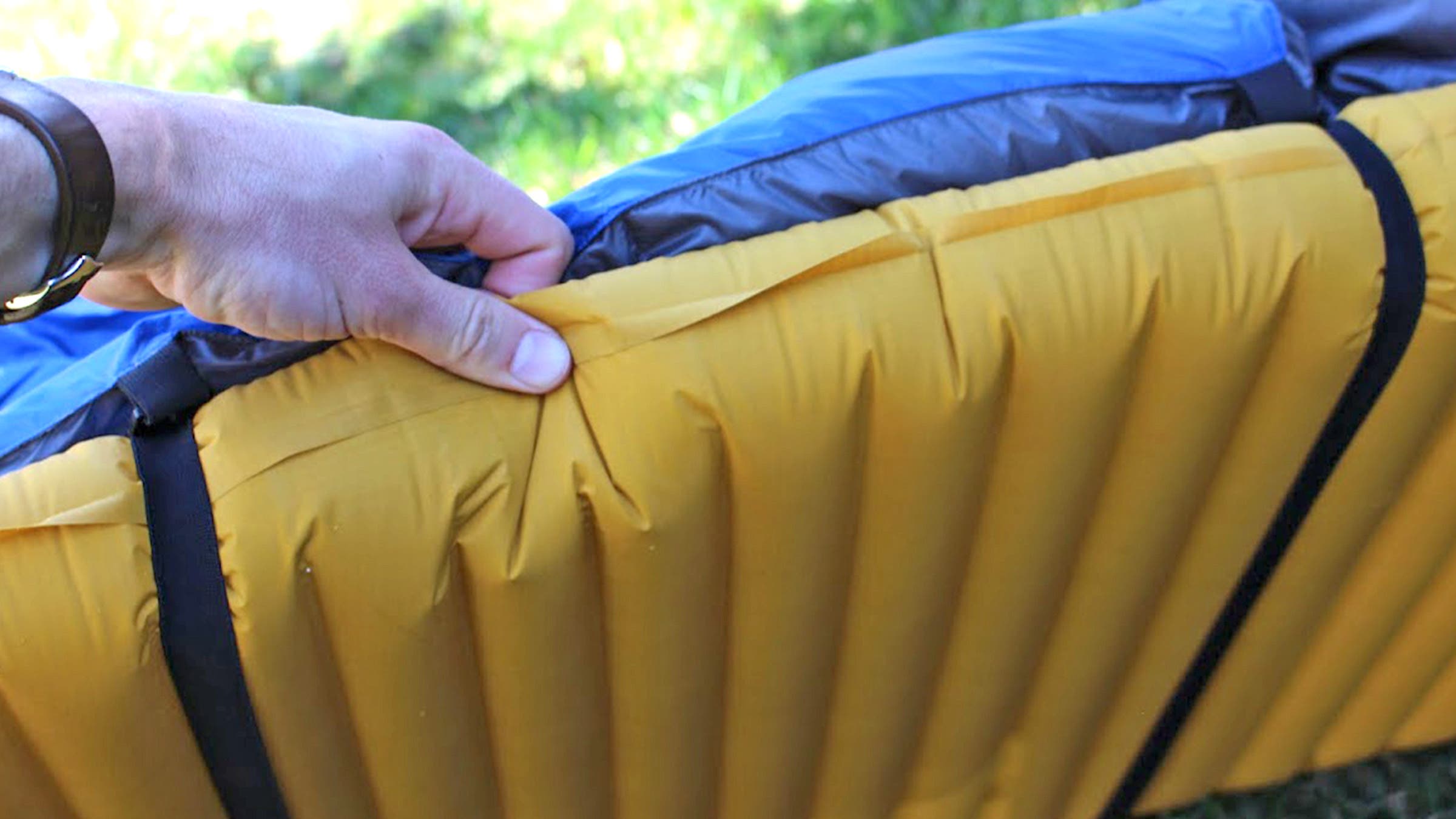
The previous iteration of this pad was notorious for its loud potato chip crinkle, owing to the reflective inner layers. Those days seem to be over: None of our testers complained about noise. Tester Pat Greehan, who used this on a three-night bikepacking race in northern Minnesota, said: “Therm-a-Rest claims it’s 83 percent quieter. While I can’t quantify that, it is substantially quieter than my two older Therm-a-Rests.”
The other selling factor for Greehan is the oversized Wing Lock Valve, which has a faster airflow rate than a standard-sized valve and is easy to manipulate with cold hands. “This system makes inflation and deflation a breeze,” he says.
The Xlite’s sizing options are tailormade for reducing weight. There’s a short (66-inch length) version that weighs in at just 11.5 ounces and a regular-wide mummy that weighs one pound. Since most of Therm-a-Rest’s competitors only offer rectangular wide pads, that weight-savings is significant, at least in the ultralight world. (The difference between the wide Xlite and the wide Tensor All-Season is 3 ounces).
While we wouldn’t lounge directly on the ground with it, the pad held up surprisingly well despite a relatively thin 30-denier high-tenacity ripstop nylon. Our inflatable pad–averse tester, Hansi Johnson, suspended his doubts and gave the Xlite NXT a try on a solo camping trip to the Boundary Waters Canoe Area Wilderness. At first, the pad felt incredibly fragile. “I am a big person and was extremely concerned about popping it,” admits Johnson, who was extra vigilant in finding dirt or grass patches in an environment notorious for its rugged, rocky, and rooty terrain. After five nights without incident, the Xlite NXT pacified Johnson’s fear of inflatables.
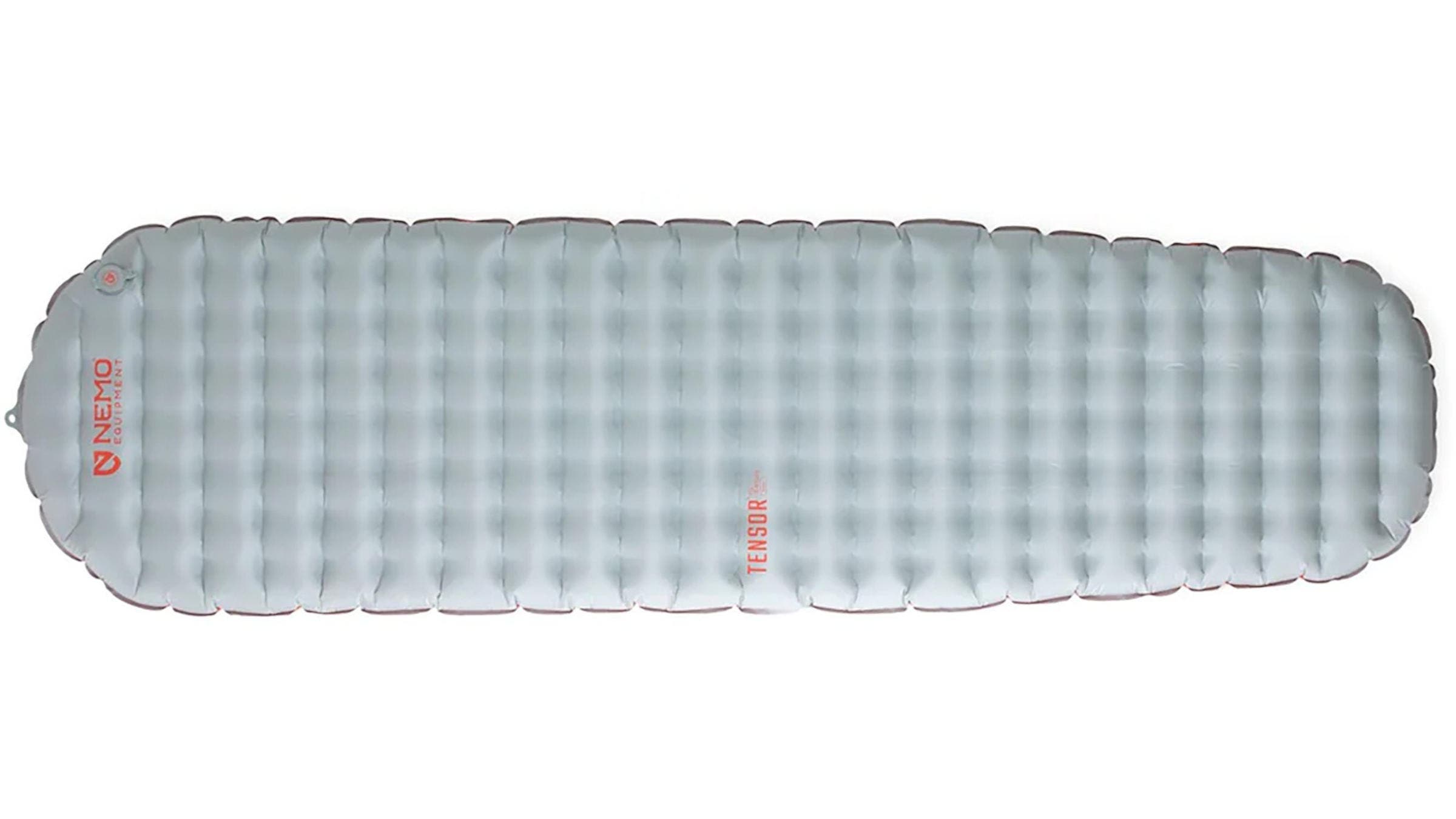
For Ultralight Side-Sleepers
NEMO Tensor All-Season ($200)
Weight: 14.1 oz
Sizes: Regular, Regular Mummy, Regular Wide, Long Wide
Thickness: 3.5 in
R-Value: 5.4
Lab-Tested Puncture Resistance (1-5): 4
Pros and Cons
+ Excellent warmth-to-weight ratio
+ Reasonably comfortable
+ Very light
𑂾Expensive
In our view, NEMO’s Tensor All-Season and Therm-a-Rest’s NeoAir Xlite NXT are the leading candidates in the world of ultralight sleeping pads. And while the Xlite gets our “Best Overall” nod for being warm and feature-rich at the lowest possible weight, the Tensor All-Season isn’t far behind—and in some ways proves superior. It weighs just over an ounce more, but it’s slightly warmer, slightly more comfortable, and available at a nearly identical price.
Comfort is the biggest deciding factor between the Xlite and Tensor All-Season, and the point that our testing team debated more than any other. In general, our testers who slept well outdoors found both pads reasonably comfortable. (Neither rank among our most comfortable pads, however.) But our side sleepers and fitful sleepers preferred the Tensor All-Season owing to its design: Gridded baffles offer more stability near the edges of the pad than the Xlite’s horizontal baffles. Add in an extra half-inch of thickness, and the Tensor takes the edge with fidgety sleepers.
The Tensor All-Season also beats out the Xlite for warmth, with an R-value of 5.4 compared to the Xlite’s 4.5. After doing A/B field testing, however, the difference in warmth wasn’t as large as those stats would suggest. Ultimately, the All-Season is slightly more comfortable when temps hit 20 degrees, but warmth shouldn’t be the deciding factor between the two.
Across other metrics, the Tensor All-Season performed well. Its 20-denier nylon top and 40-denier bottom fabrics are a good mix of weight-savings and durability (just remember to keep the pad right-side-up each night). It ships with a generous inflation sack that moves plenty of air. And, although it’s far quieter than past versions of Tensor pads, it still has a slight crinkle sound when you move around—a deal-breaker for some backpackers.
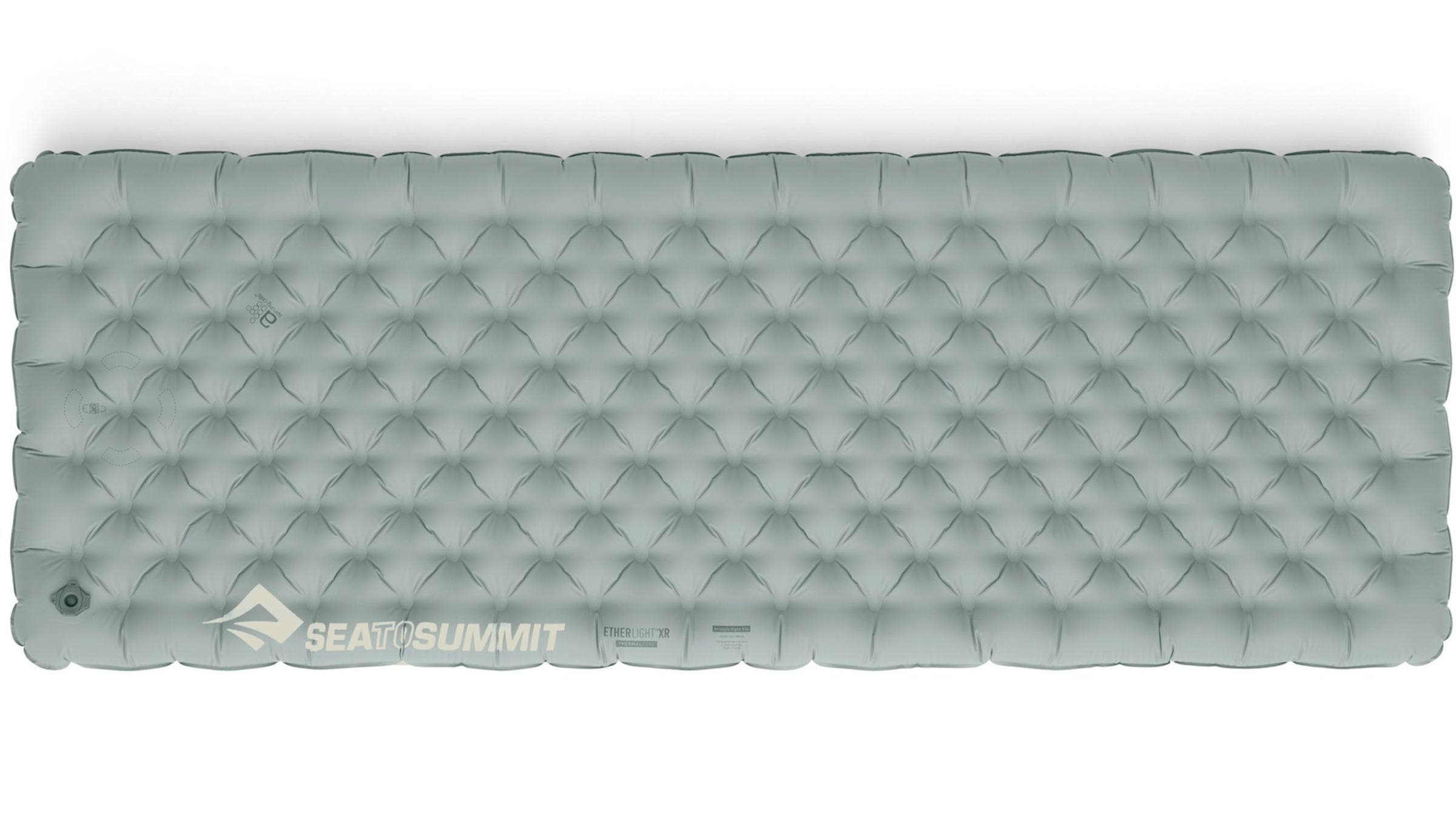
Best Features
Sea to Summit Ether Light XR ($200)
Weight: 16.6 oz (regular)
Sizes: Small, Regular, Large, Regular Rectangular Wide, Large Rectangular
Thickness: 3.9 in
R-Value: 4.1
Lab-Tested Puncture Resistance (1-5): 4
Pros and Cons
+ Incredibly comfortable baffle design
+ Super thick
+ Improved durability
𑂾Lesser warmth-to-weight ratio
𑂾Top-tier price
The predecessor to Sea to Summit’s Ether Light XR pad, the Ether Light XT, was a decent pad that ultimately failed to provide the warmth and durability offered by rivals from Therm-a-Rest and NEMO. This year’s new XR is a drastically-changed pad from the XT, with a higher R-Value, lower weight, smaller packed size, and most importantly, stronger baffle welds. With the XT, baffle failures had become an unfortunately frequent complaint among our testers. With durability concerns assuaged, we can now appreciate the XR for what it is: one of the most comfortable pads in the one-pound range.
In terms of raw warmth-to-weight metrics, the Ether Light XR still can’t compete with the two heavy hitters, Therm-a-Rest’s NeoAir Xlite NXT and NEMO’s Tensor All-Season. But the XR’s “air-sprung cell” baffle tech, a diagonal grid of welds, reduces pressure points and provides better support than either of its ultralight rivals. Sea to Summit pioneered that mattress-like air sprung tech nearly a decade ago, and it remains the most comfortable construction for an lightweight inflatable pad even today. There are competitors with similar baffle grids, like the REI Helix and Zenbivy Ultralight Mattress, but the Ether Light XR is the best of the lot, with an extra inch of thickness and taller edge baffles that serve as “rails” to keep you centered on the pad.
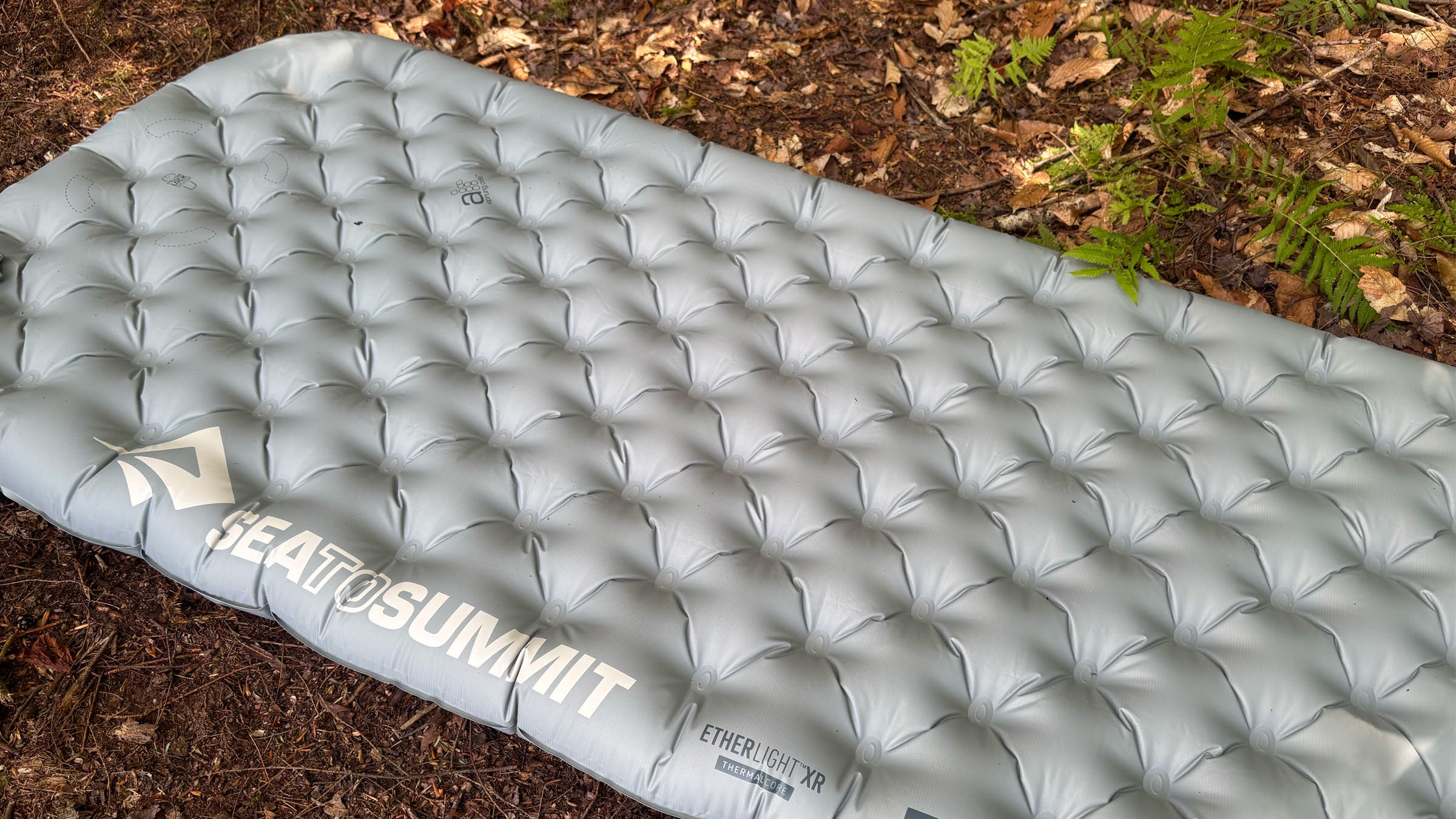
The XR is substantially warmer than the XT it replaces thanks to a new insulation design: The XT had a combination of synthetic insulation and reflective layers; the XR forgoes the synthetic fill for an extra reflective layer. (As an added bonus, it’s quiet: the crinkly, “potato chip bag” sounds that plague our other top picks are hardly audible.) The bump in R-Value (from 3.2 to 4.1) is noticeable in the field: testers say it’s warm down to freezing temps.
Finally, the XR comes with a few quality-of-life upgrades that testers appreciated. “Its functionality is well worth the three ounces I’d add to my pack compared to my NeoAir. The ease of inflation and the comfort stand out considerably,” says tester Bruce Etter, an Appalachian and Pacific Crest Trail thru-hiker.
The stuff sack doubles as an inflation bag, and was among the most efficient we tested, with no narrow bottlenecks to reduce airflow. We could inflate the bag with one breath, and the pad with 2-3 compressions of the bag. And for anyone with a Sea to Summit pillow made after 2019, the XR comes with Velcro attachments to keep your pillow and pad connected.
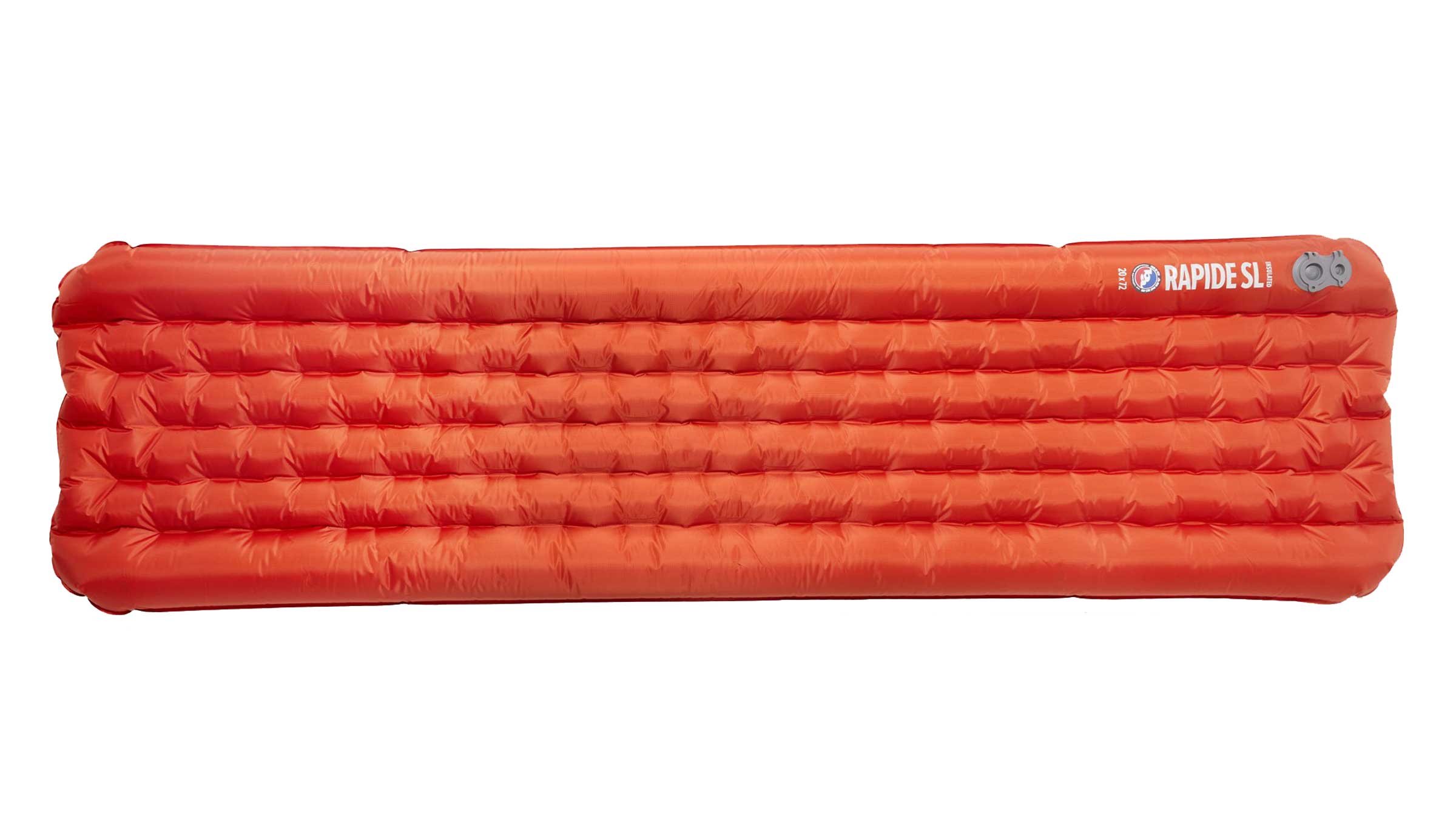
Best Value
Big Agnes Rapide SL Insulated ($150)
Weight: 1 lb, 2 oz (Regular)
Sizes: Petite, Regular, Long, Wide Regular, Wide Long, Double Wide
Thickness: 4.25 inches
R-Value: 4.8
Lab-Tested Puncture Resistance (1-5): 4
Pros and Cons
+ Warm
+ Durable
+ Plenty of sizes
𑂾Learning curve for the inflation sack
The updated Rapide SL is better than its predecessor in every way: an ounce lighter; a half-inch narrower and one inch shorter when rolled up; and a higher R-value to boot. After shivering on similarly compact, lightweight pads, our testers were suspicious that this squat little package—smaller than a Nalgene bottle—could really crank out an R-value of 4.8 and still be comfortable. We were wrong. The Rapide SL provided a solid night’s sleep for two Minnesota testers, one who used it to camp during a high school mountain bike race in late August, the other who slept out under the stars sans-tent on at Lake Vermilion near the Canadian border.
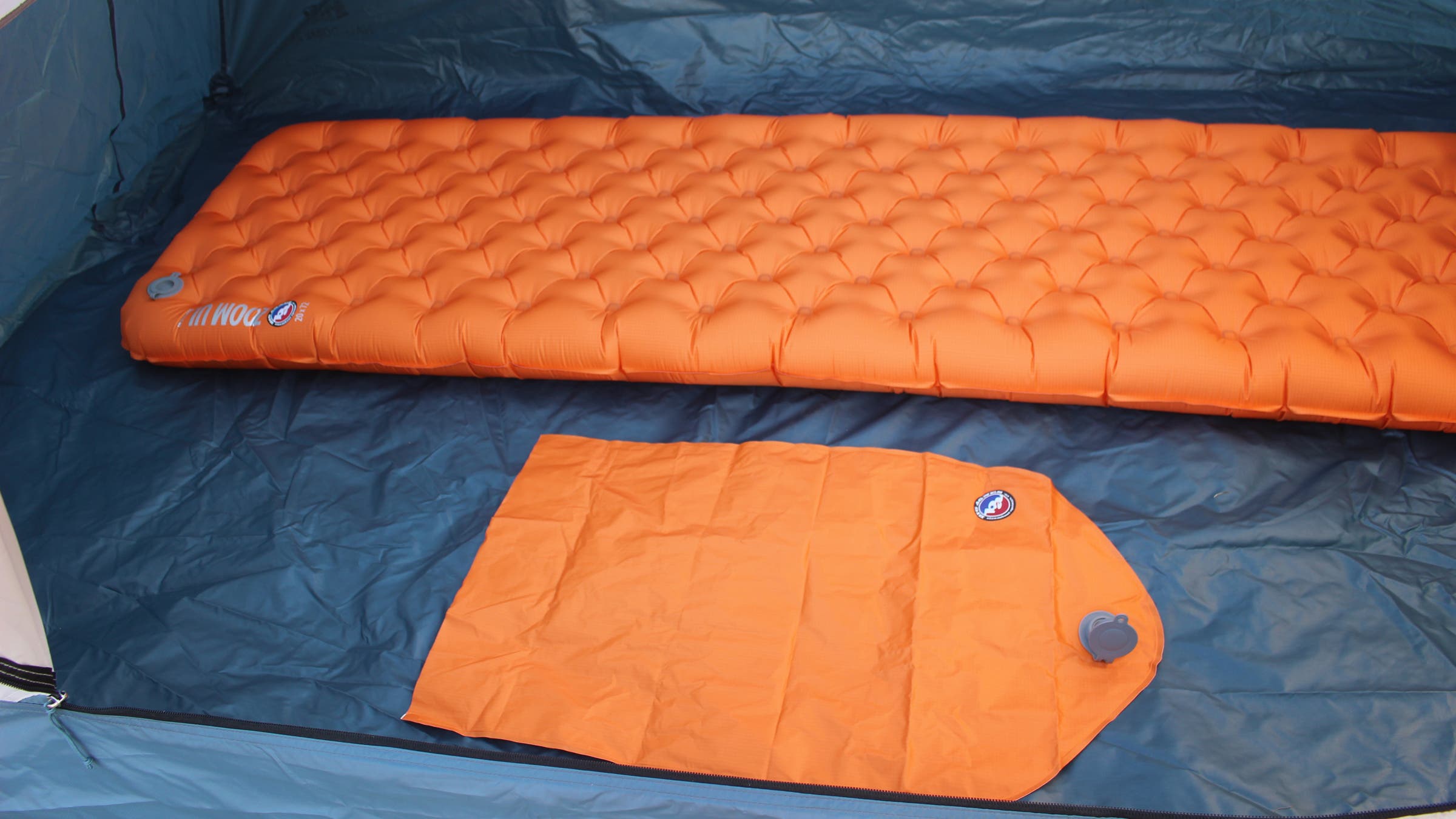
The exterior fabric is a fairly durable, 40-denier nylon double ripstop that is bonded to a special blend of TPU that contains a heat-reflective and antimicrobial additive. To provide structure, the pad’s interior has rows of offset I-beams dispersed throughout, similar to what you’d see holding up an industrial warehouse. Perimeter baffles kept our testers squarely on the pad, even with a four-and-a-quarter-inch-thick height—tall for such a narrow pad. Two layers of heat-reflective film help give the pad its impressive R-value. All that, and it’s still one of the cheapest top-shelf sleeping pads on the market.
Thanks to that supportive, heat-retaining tech, one tester slept like a baby on the Rapide SL during a late summer cowboy camp in near-freezing northern Minnesota, even with rumors of a cougar on the prowl near the campground.

Best Ultralight
NEMO Tensor Elite ($230)
Sizes: Regular mummy and short mummy
Weight: 8.5 oz (regular), 7.6 oz (short)
Thickness: 3.5 inches
R-Value: 2.4
Lab-Tested Puncture Resistance (1-5): 1
Pros and Cons
+ Lightest pad on the market
+ Reasonably warm and plush
𑂾Delicate
𑂾Underpowered inflation sack
The NEMO Tensor Elite was the lightest pad we tested this year, and at just 8.3 ounces, it wasn’t a particularly close race. Luckily, the Tensor Elite wasn’t just light, it also proved reasonably durable and comfortable during testing, surviving 920 miles on the Pacific Crest Trail, plus repeated two- and three-day trips in the Canadian Rockies. After all that, the Tensor Elite actually proved comfier and warmer than we expected. At 3 inches thick, it’s only a half-inch slimmer than other pads in the Tensor line, and on par with Therm-a-Rest’s NeoAir Xlite and Xtherm pads. Our tester who weighs more than 200 pounds reported bottoming out while rolling side-to-side, but testers in the 150 to 180 pound range had no issues. The Tensor Elite’s ability to keep us warm was another nice surprise. We had no issue pushing this pad into the fall season, with testers reporting that they could begin to feel the cold at temperatures between freezing and 40 degrees. NEMO’s reported R-value of 2.4 seems accurate, and goes beyond what we expected from such a lightweight pad.
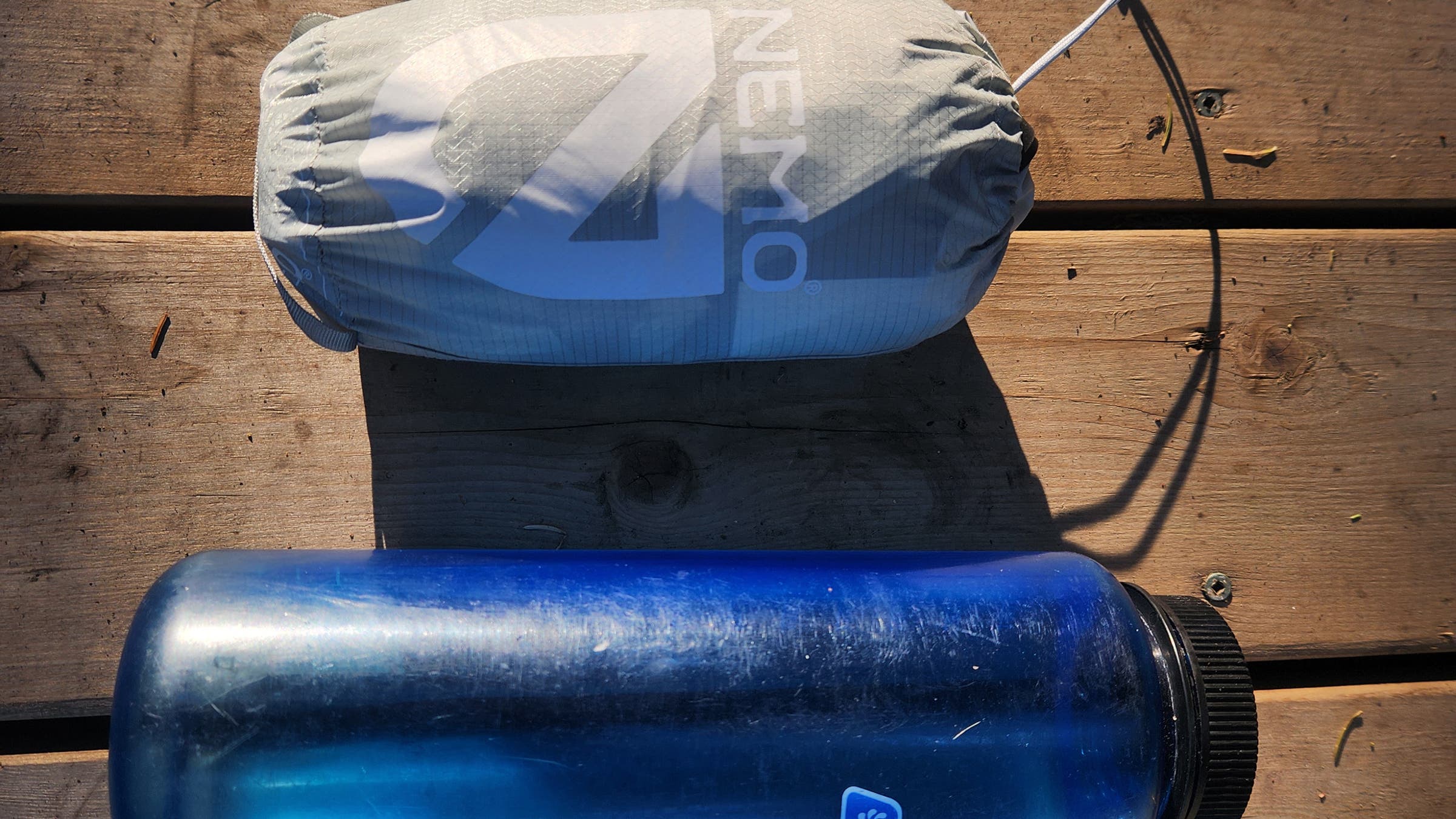
As for durability, the Tensor Elite’s 10-denier nylon fabric does require some extra attention. After several months of testing, we managed to create a few pinhole leaks—but that was only once we abandoned careful campsite selection in favor of stress-testing the pad against rocks, gravel, and brush. Our PCT tester, Camille Wood-Foucar, slept with a thin foam pad beneath the Tensor each night and never encountered a leak.
In addition to its light weight, this pad packs down incredibly small. “It’s amazing how far the technology has come,” said our tester in British Columbia. “This thing is tiny, about the size of a fist when rolled up.” Testers also said the pad was quiet—there’s the swoosh of nylon, but none of the dreaded crinkle. And the soft plastic inflation valve was easy to use and remove for rapid deflation. One downside: Testers thought the supplied inflation sack, which narrowed down to just a small channel near the valve, didn’t move enough air. But thanks to the Tensor Elite’s relatively small size, ditching the sack in favor of using lung power wasn’t a big deal.
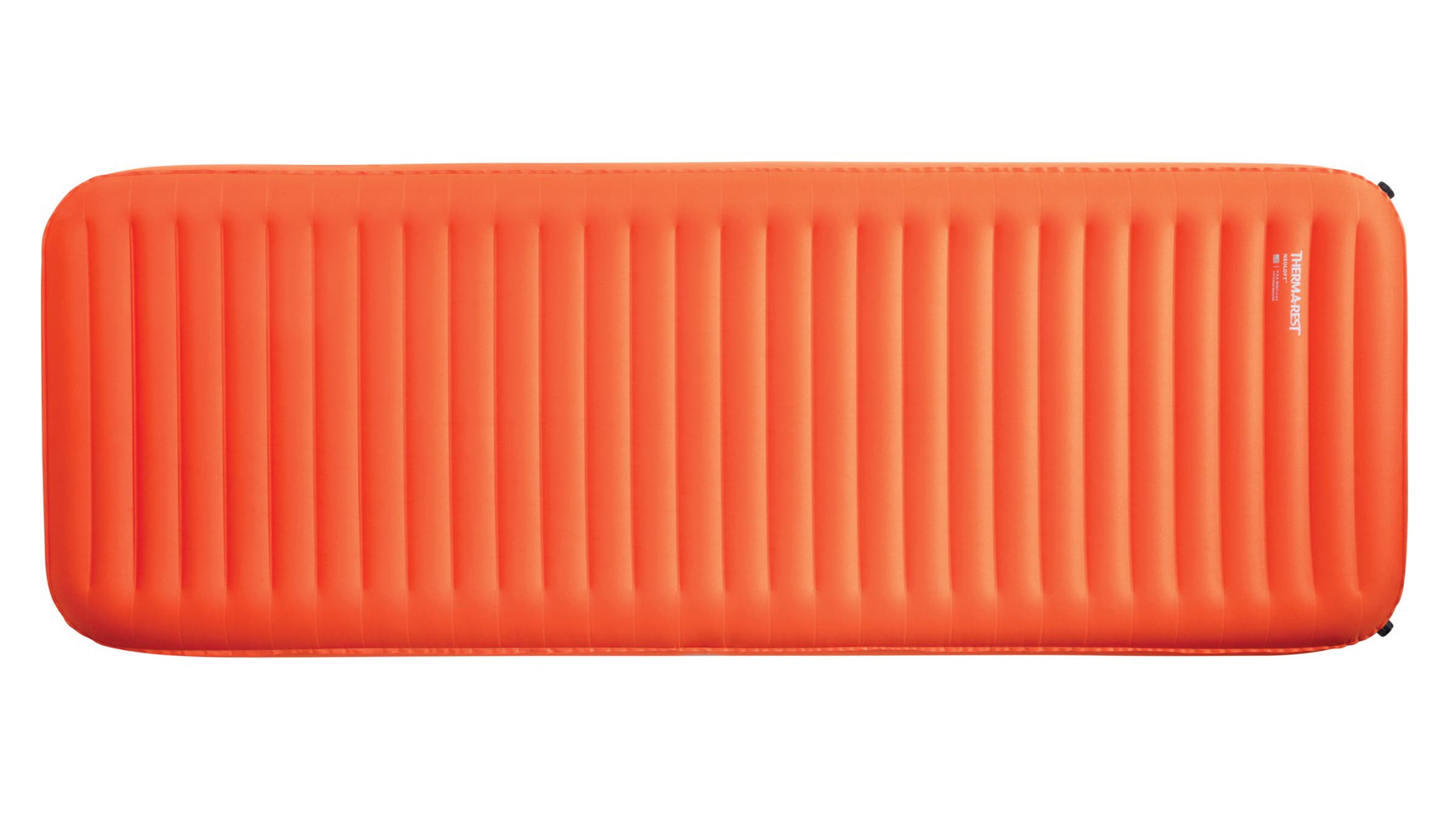
Most Comfortable
Therm-a-Rest NeoLoft ($240)
Price: $240
Size: Regular, Regular Wide, Large
Weight: 1 lb 9 oz (regular), 1 lb 14 oz (regular wide), 2 lbs (large)
Thickness: 4.6 inches
R-Value: 4.7
Lab-Tested Puncture Resistance (1-5): 4
Pros and Cons
+ Comfort and support of a car-camping mattress
+ No crinkly noises
+ Warm
+ Smart inflation valves and sack
𑂾Fairly heavy
The NeoLoft is the only sleeping pad we’ve ever tested that is both as comfortable as a proper car camping pad and light enough to use for true backpacking trips. If you’re after mattress-like comfort, look no further. The NeoLoft, which weighs in at 25 ounces in the regular size (it also comes in regular-wide and large), is built to be plush above all. For the comfort-minded, it solves nearly every problem you might have with other inflatable pads, including Therm-a-Rest’s own highly-touted NeoAir line. It’s 4.5 inches thick, easily the loftiest in our testing. That’s enough extra height to keep even heavier side sleepers from bottoming out. It’s also fully rectangular, giving you more pad under your hips, knees, and feet. It switches up the inflation system, with two one-way valves that move air faster compared to the two-way valve found in the NeoAir line, and includes an extra-large inflation sack. The bigger sack and faster valves are a smart move given the quantity of air the NeoLoft requires—inflating it only takes about 30 seconds longer than the XLite NXT.
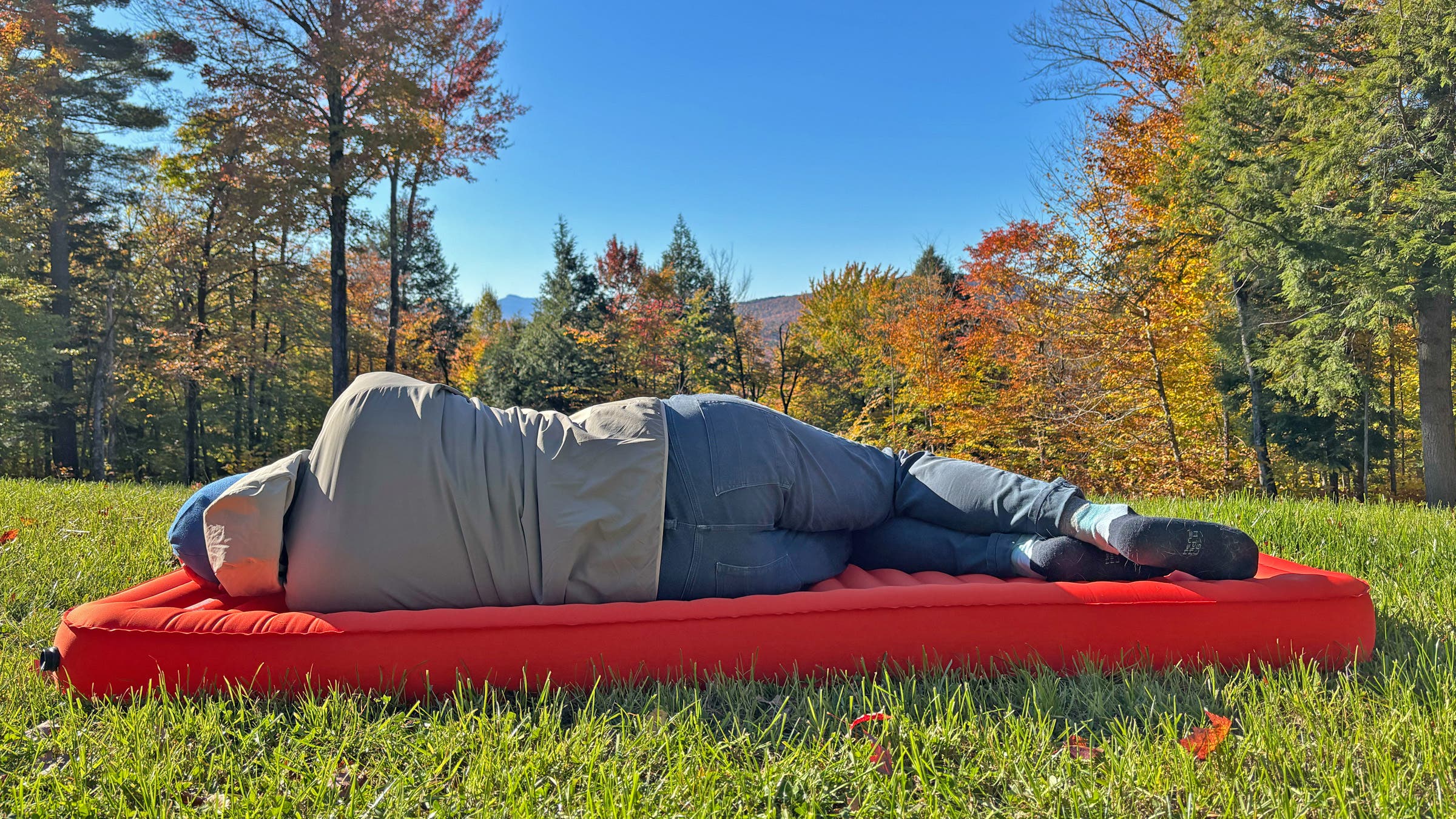
Best of all, it solves one of our biggest irks about many lighter pads—the slippery, horizontal air chambers that seem to shoo you off the pad in the middle of the night. While the NeoLoft also has horizontal chambers, they’re fully wrapped by a raised air chamber around the perimeter of the pad. “It’s like the entire pad has a guard rail that coaxes you back to the sweet spot,” one tester reported.
And while the NeoLoft is relatively heavy for a backpacking pad, it’s worth noting that the weight comes from comfort- and durability-oriented materials. Unlike nearly every other backpacking pad out there, the NeoLoft is not made from crinkly and slippery nylon. Instead, it’s wrapped in a thicker, soft and stretchy knit polyester (the top fabric is 50-denier, the bottom 75). It’s pleasant to the touch—one tester said the fabric feels similar to his favorite sun hoodie—and quiet. If you’re a light sleeper who can’t fall asleep faced with the cacophony of crinkling that most pads create, the NeoLoft will be a welcome change.
Our testers agreed that the combination of the sidewalls, guard rails, and air chamber design really does give the NeoLoft a greater sense of support and stability than any other backpacking pad on the market. “It’s just next-level comfort,” one tester said after three nights atop the NeoLoft at lakeside campsites in Idaho’s Sawtooth Range.
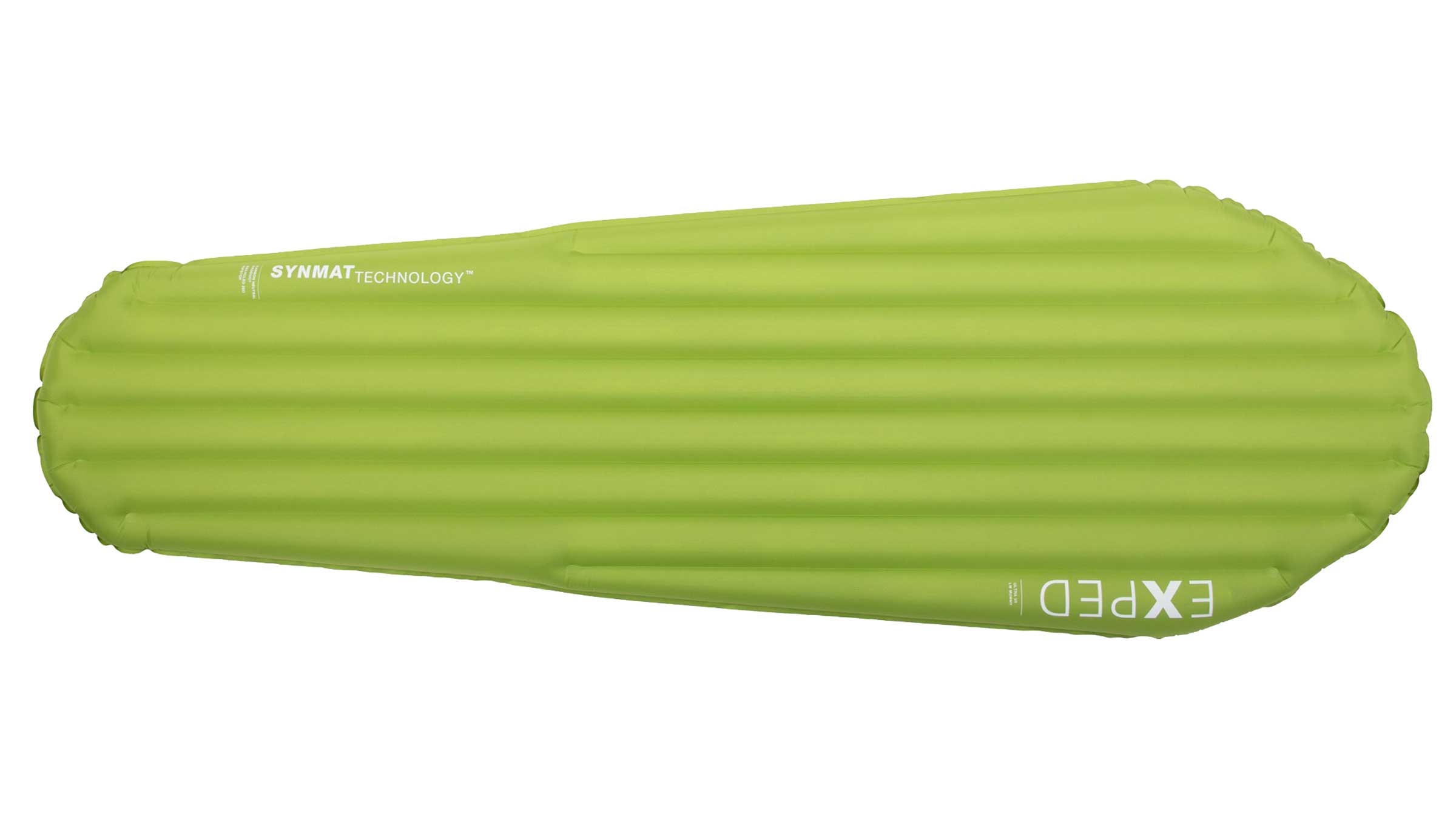
Plushest Summer Pad
Exped 3R Mummy ($140)
Weight: 12.9 oz (medium)
Sizes: Medium, Medium-Wide, Long-Wide
Thickness: 3 inches
R-Value: 2.9
Lab-Tested Puncture Resistance (1-5): 3
Pros and Cons
+ Cradle design
𑂾Middling warmth-to-weight ratio
𑂾Fragile
Longtime Outside gear tester Stephanie Pearson avoids sleeping on mummy pads at all costs. The 5-foot, 9-inch insomniac prefers the added pack burden of a rectangular design to slipping off the edge in the middle of the night. But the Exped Ultra 3R had her rethinking that anti-mummy stance: It has vertical baffles running the entire length, with two slightly taller exterior cradling baffles that kept Pearson on the mat while camping along the north shore of Lake Superior, despite her tendency to squirm. It also helped that the Ultra 3R is 20.5 inches wide, a half-inch wider than most “regular” mummies. (It comes in a wide version, too.) This allowed for slightly more sprawling without noticeably increasing the pad’s packed size, which is roughly the dimensions of a banana bread loaf.
With 60 lofted grams of insulation welded to the top and bottom, which helped eliminate cold spots, the Ultra 3R has a solid summer insulation value of 2.9. Pearson tested the soft, 20-denier ripstop polyester pad on a windy, late-August weekend on Caribou Lake in northern Minnesota. The thin denier doesn’t inspire confidence over rough substrate, but it handled an unmanicured grassy shoreline without issue. The weather that weekend ranged from biting wind that tossed the tent flaps around to heavy dawn fog that resulted in a thick coating of dew, with temps in the high 40s. Paired with a 30-degree bag, Pearson never felt chilled. For colder temps, Exped offers two more pads in the Ultra lineup, the 5R and 7R, with higher R-value ratings.
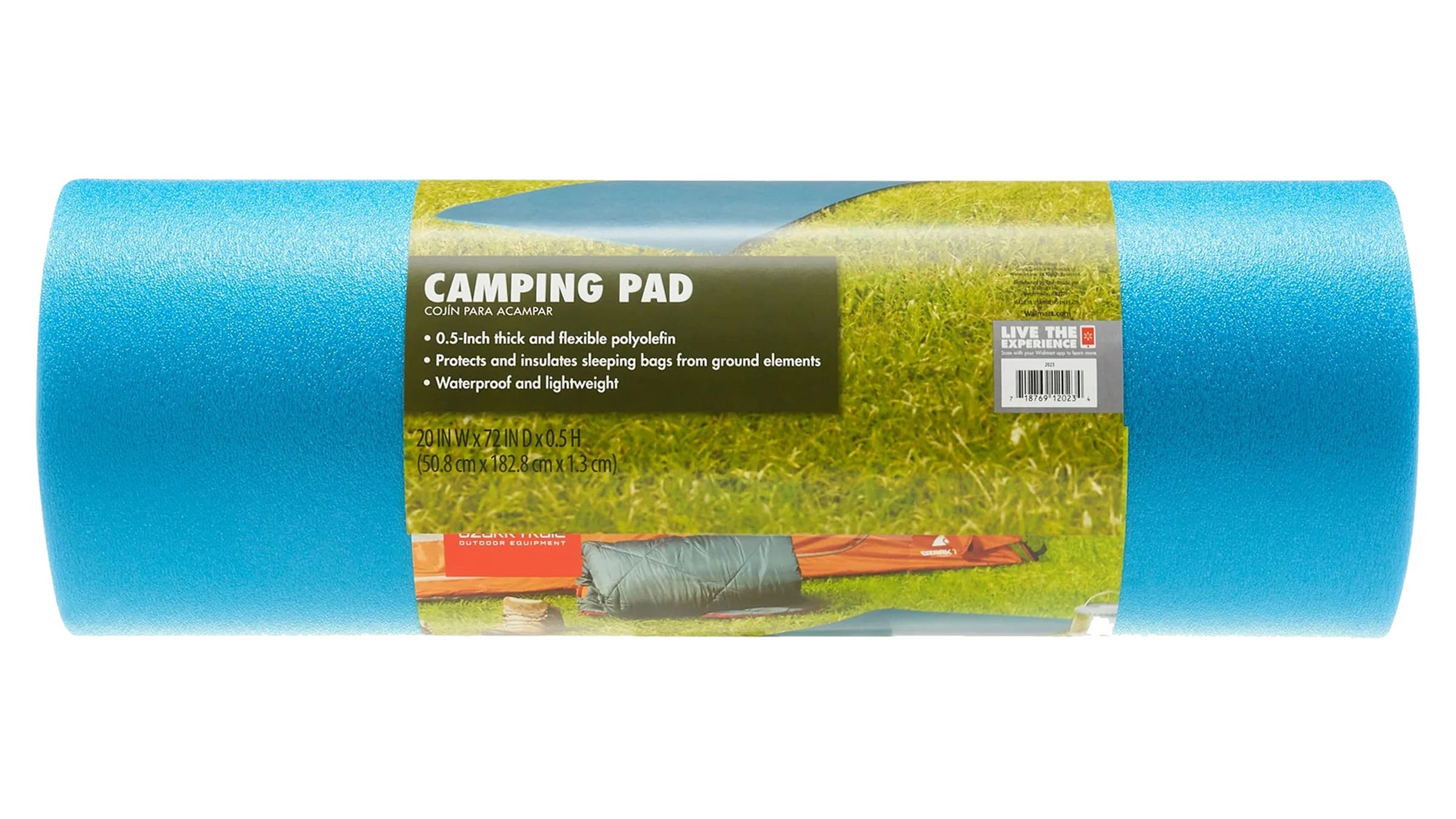
Best Closed Cell Foam
Ozark Trail Camping Pad ($15)
Price: $15
Size: One size
Weight: 11.2 oz
R-Value: 1.4
Pros and Cons
+ Durable
+ Very inexpensive
𑂾Uncomfortable
𑂾Not warm
For the lucky few who find foam pads comfortable, the Ozark Trail, found in Walmarts across the country, is hard to beat. At just $15, it’s easily the most affordable pad option out there. It’s also highly durable, waterproof, and fairly light, weighing in a few ounces less than competitors like the Therm-a-Rest Z Lite or NEMO Switchback.
Not everyone can get a good night’s sleep on these glorified yoga mats. Like most foam pads, this one is supportive but stiff and requires excellent campsite selection. “Every time I use one, it seems like I can feel every rock and root underneath me,” one tester. It’s also bulky (this one can only be rolled up, not folded), and with an R-value under 2, is relegated to summer use.
According to the lone member of our testing team who actually prefers a foam pad to an inflatable, the blue foam pad’s real advantages are durability and versatility. During a thru-hike of the Colorado Trail, he used the pad as a makeshift backpanel in his frameless pack, which negated the pad’s bulky packed size, one of its biggest downsides. It was also cheap enough that he had no qualms about cutting it down to the exact size and shape he wanted. And while other foam pads, like the Z Lite, have dimples that create a slightly spongier sleeping surface, the comfort difference over the course of a night isn’t a game changer. We also found that the Ozark Trail’s half-inch of thickness was the sweet spot for usable comfort: Thinner options like the eighth- or quarter-inch pads available from brands like Outdoor Vitals, Gossamer Gear, or Mountain Laurel Designs are simply too thin to provide much comfort when used on their own.
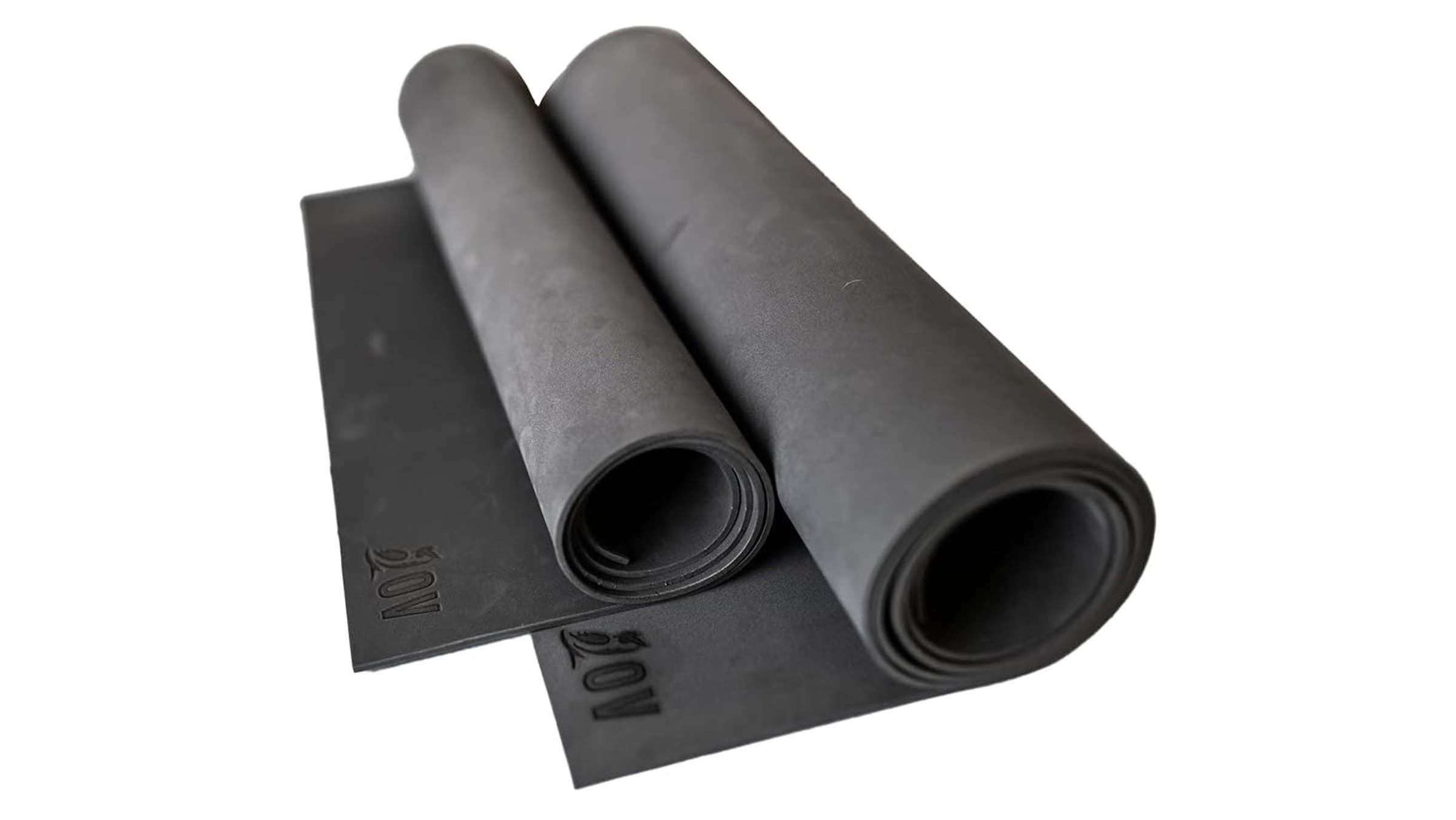
Best Backup Pad
Outdoor Vitals 1/8-Inch Pad ($25)
Price: $25
Size: Regular, Long-Wide
Weight: 2.5 oz
R-Value: 0.5
Pros and Cons
+ Inexpensive
+ Lightweight
𑂾Very uncomfortable when used alone
𑂾Not warm
In 2025, a top flight sleeping pad can run north of $200, making it a serious gear investment that’s worth protecting. The best way to do that is with a thin foam pad like the Outdoor Vitals 1/8-Inch Closed Cell Foam Pad, which will set you back just $25 and add a scant 2.5 ounces to your pack. For most of us, something this thin could never serve as a standalone pad except on the softest of pine needle beds. Our preferred use for a pad like this is as a protective layer between our main pad and the ground, where it offers fantastic insurance against sharp roots, rocks, and thorns that wreak havoc on inflatable gear. In the event of a puncture or leak, it also offers a bit of protection and warmth compared with laying on the cold, hard ground. Finally, there are a number of multi-purpose benefits to carrying one, including using it as a sit pad, a backpanel for ultralight packs, or a yoga mat. Because it weighs so little (and folds up to the size of a hefty burrito), it’s now a non-negotiable item in my own packing list, even on trips where I’m cutting every ounce I can.
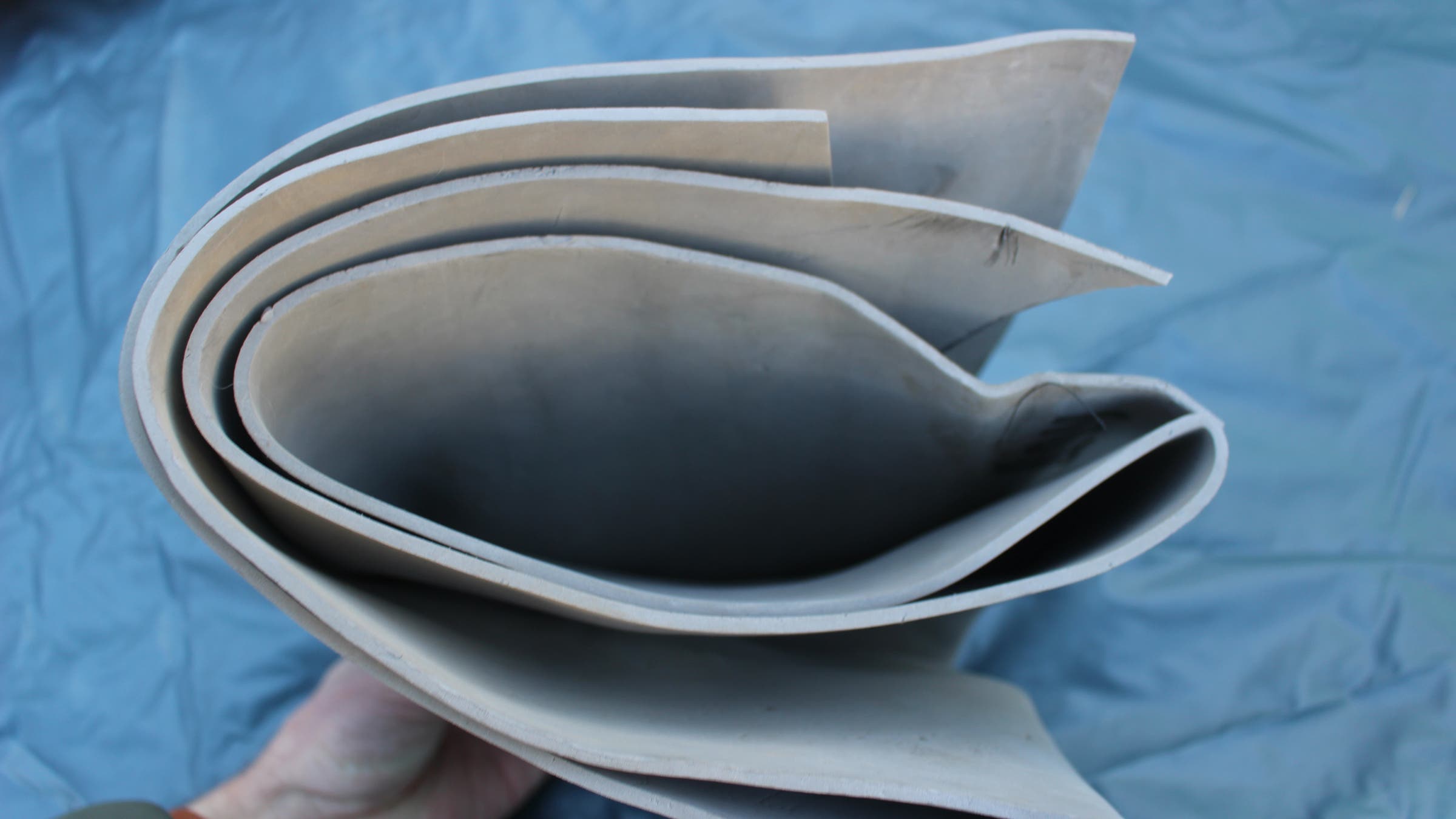
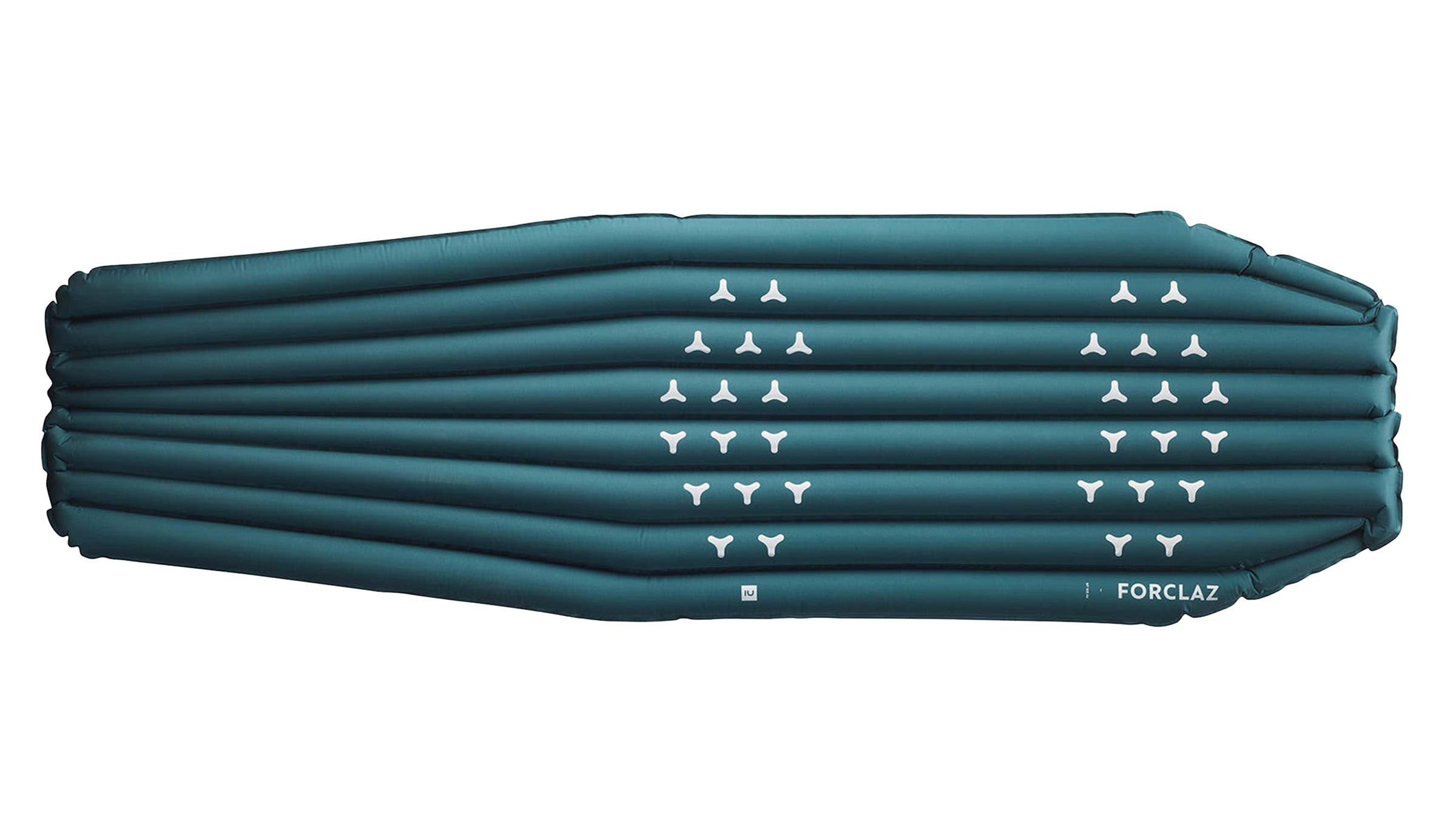
Best Inflatable Under $100
Decathlon Forclaz MT500 ($70)
Price: $70
Size: Large and Extra-Large
Weight: 18 oz
R-Value: 1.5
Lab-Tested Puncture Resistance (1-5): 5
Pros and Cons
+ Fairly cheap
+ Silicone patches for grip
+ Separate inflation/deflation valves
𑂾Not warm
𑂾Poor cushioning
If you want the warmth, features, and feathery weight of a top-tier pad, you’ve gotta shell out for it—there are no truly budget pad options currently on the market that tick all the boxes. If spending $200-plus is not an option, check out the Decathlon Forclaz MT500, which was our favorite pad available for less than $100. At that price tag, its feature set is hard to top: two inches of air cushion, an R-value of 1.5, and a weight of 18 ounces. There were even a few features testers appreciated that were lacking on some spendier models, like the separate inflation and deflation valves—which allow for much faster deflation than a two-way valve—and non-slip silicone patches that kept sleeping bags from sliding around. The vertical baffles were another perk, especially for our side-sleeping testers who found that the baffles helped keep them centered on the pad, even with no elevated side rails. The fabric, a blend of 43 percent polyester and 57 percent TPU, was quiet and durable, and never leaked after a summer of testing in rocky campsites across the Pacific Northwest. What do you give up for the low price? Versatility, for one. Any pad with an R-value below 2 should be considered a summertime pad only: Our testers could feel the cool air start to creep in in temps below about 45 degrees. Testers also noted that its 2 inches of thickness was serviceable with good campsite selection, but compared to models that boast 3.5 inches or more, paled in support for side-sleepers and on rocky ground. Finally, the MT500 comes sans inflation sack, which isn’t a dealbreaker, but is a basic feature on most modern inflatables.
Honorable Mentions:
Sea to Summit Pursuit ($149): There are no self-inflating pads in our top 10 picks, and for good reason—very few offer the low weight, packability, and plush comfort that manually-inflated pads do. But if you’re a fan of the durability and ease of a self-inflator, our top pick is the new Sea to Summit Pursuit. With a weight in regular size of 1 pound, 5 ounces, it’s one of the only self-inflating pads that is even close to rivaling its more modern competitors. Add in an R-Value of 3, two inches of foam insulation, and the Pursuit is a perfectly capable option, even if its raw metrics aren’t eye-popping.
Big Agnes Zoom UL ($180): If you find the NeoAir Xlite NXT’s horizontal baffles uncomfortable, the Zoom UL is a close competitor in specs. It boasts a similar R-value of 4.3, half an inch of extra thickness, and a diamond-shaped baffle system that some of our testers found more stable than the NeoAir. Plus, you’ll save $30.
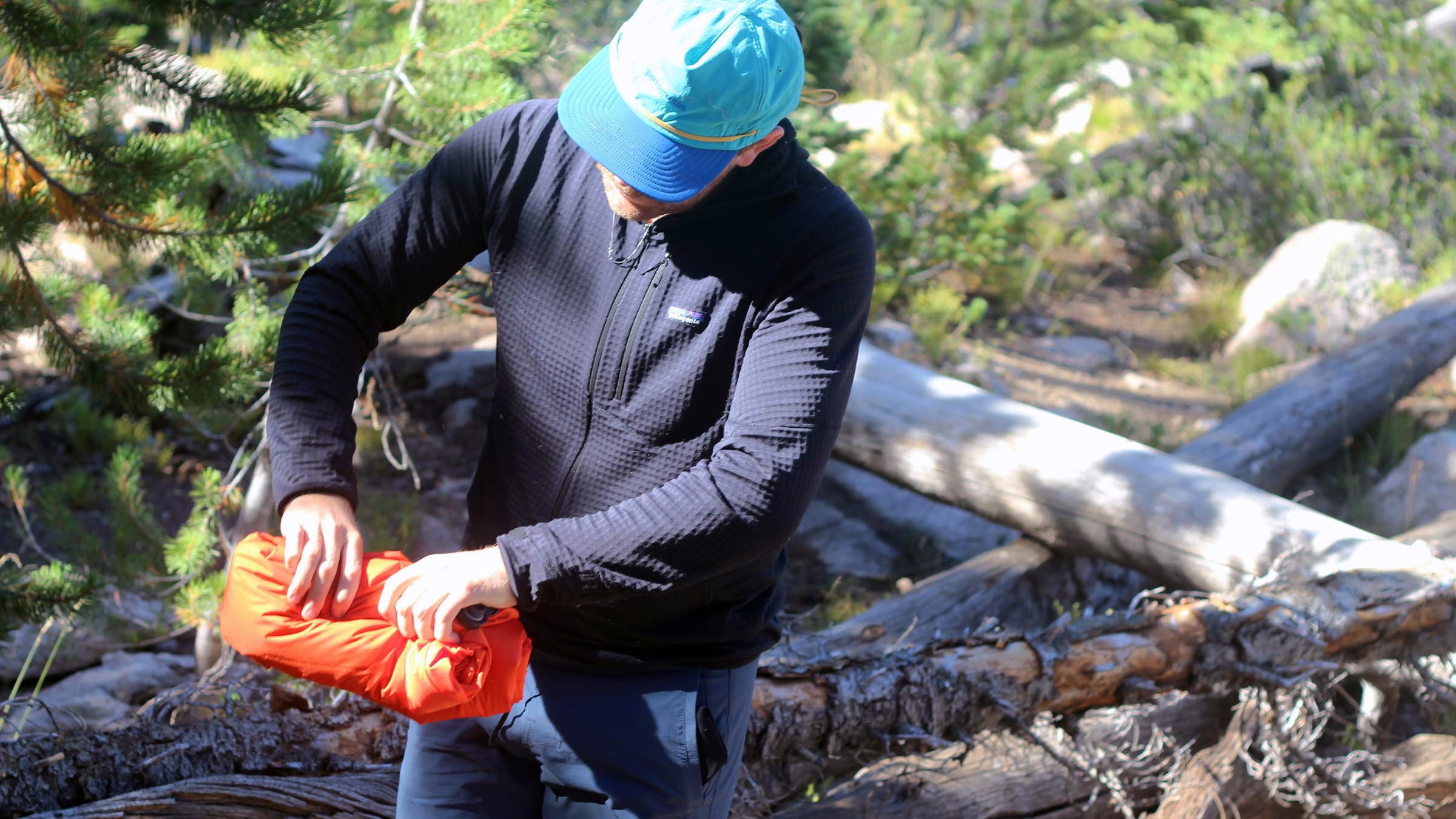
How to Choose a Sleeping Pad
For such a seemingly simple piece of gear, sleeping pads are surprisingly complex. Buy the wrong one—whether too short, too narrow, too delicate, too heavy, too cold, or too hot—and a camping trip can quickly turn into a sleepless purgatory. Before you buy, there are three major factors to keep in mind.
The Type of Pad
Closed-Cell Foam: Lightweight, inexpensive, and virtually indestructible, closed-cell mats are a decades-old favorite. The downside? They’re bulky, have low R-values, and aren’t particularly comfortable.
Inflatable Pads: These pads, which derive their insulative properties from air and often some combination of synthetic or down fill and reflective layers, are lightweight and extremely packable. The flipside is that they can be punctured, rendering them useless if you can’t properly patch them in the field.
Self-Inflating Pads: Self-inflating pads insulate with a combination of air and open cell foam. These pads can be quite warm, comfortable, durable, and also (eventually) inflate on their own. They tend to be bulkier and heavier than air pads.
What about R-Value?
This ubiquitous term will inevitably crop up when searching for the most appropriate pad for your outdoor activity. R-value is a universal measurement that rates a sleeping pad’s ability to resist heat transfer. R-values in sleeping pads typically range from one to seven. A pad with an R-value of up to 2 works in temps with an expected nighttime low of 50 degrees Fahrenheit; an R-value between 2 to 3.9 works in temps with an expected nighttime low of 32 degrees; an R-value between 4 to 5.4 works in temps with an expected nighttime low as cold as 15 degrees; and a pad with an R-value of 5.5 or higher works in temps down to an expected nighttime low of zero degrees. That said, everyone has a different cold tolerance; the best test is a trial run in your backyard.
Intended Use
What time of year, where, and how you intend to use your pad are crucial pieces to the puzzle. Bikepackers who race Alaska’s Iditabike will want to invest in an ultralight, insulated air pad with a high R-value. Car campers might want to take advantage of the extra space and splurge on a double, self-inflating pad. Thru-hikers who can’t afford a puncture and have space to strap their pad to the outside of their pack may gravitate toward a closed cell foam pad.
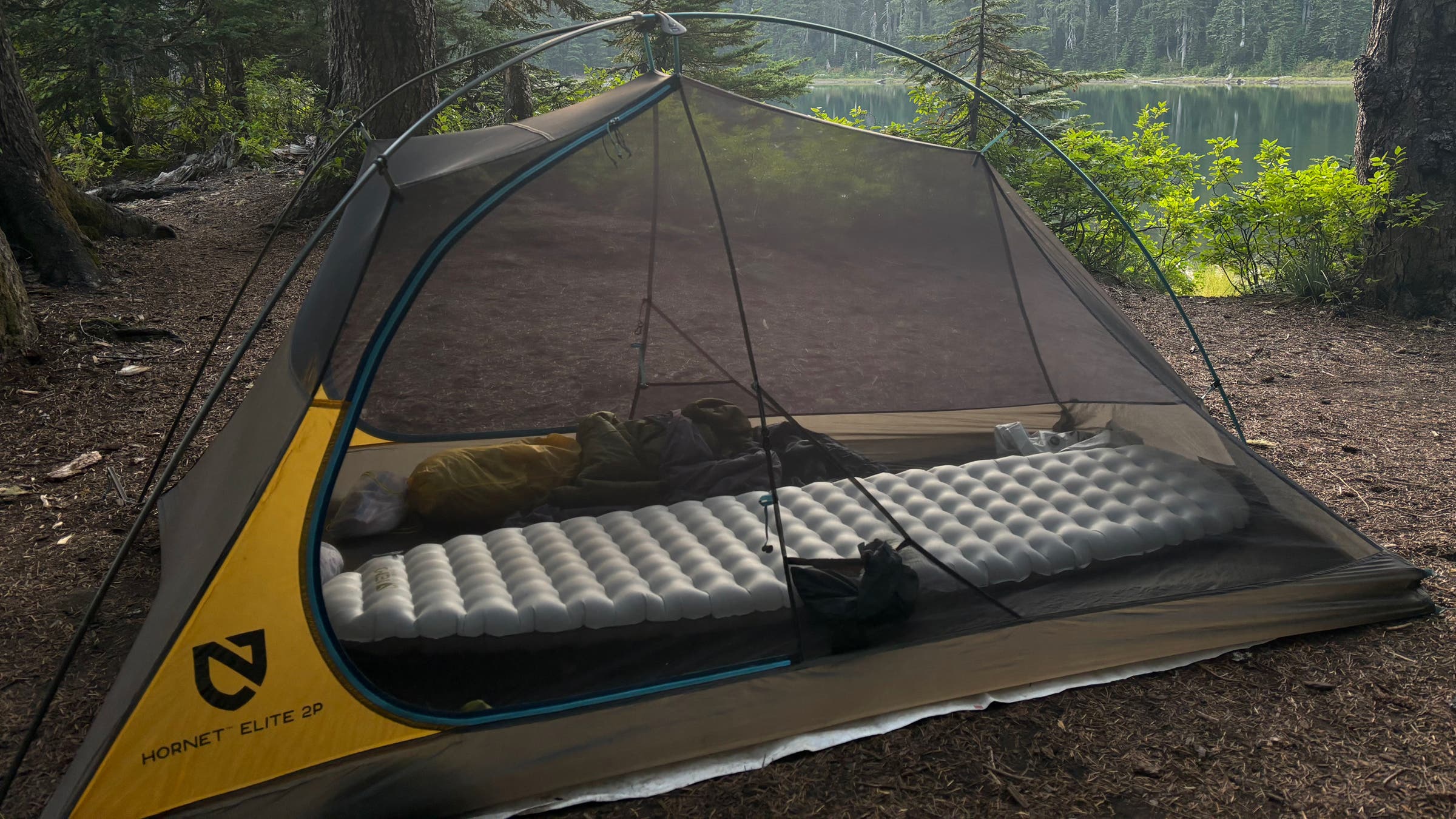
How We Test Sleeping Pads in the Field
- Number of Testers: 13
- Number of Pads Tested: 31
- Number of Nights Slept Outside: 107
- Coldest Night: 14 degrees
- Warmest Night: 78 degrees
- Pads repaired: 3
Every year, our team of hikers and backpackers test the newest sleeping pads against tried-and-true favorites that we’ve learned to trust during thru-hikes, expeditions, and outdoor jobs like wildland firefighting. We regularly test pads in places across the country, including Alaska, New Hampshire, and Colorado. Pads hit the ground in national parks, remote wilderness areas, and parking lots (just once, while waiting at a trailhead for a ride into town). During testing, we ask our team for detailed feedback related to comfort, warmth, ease of use, and durability.
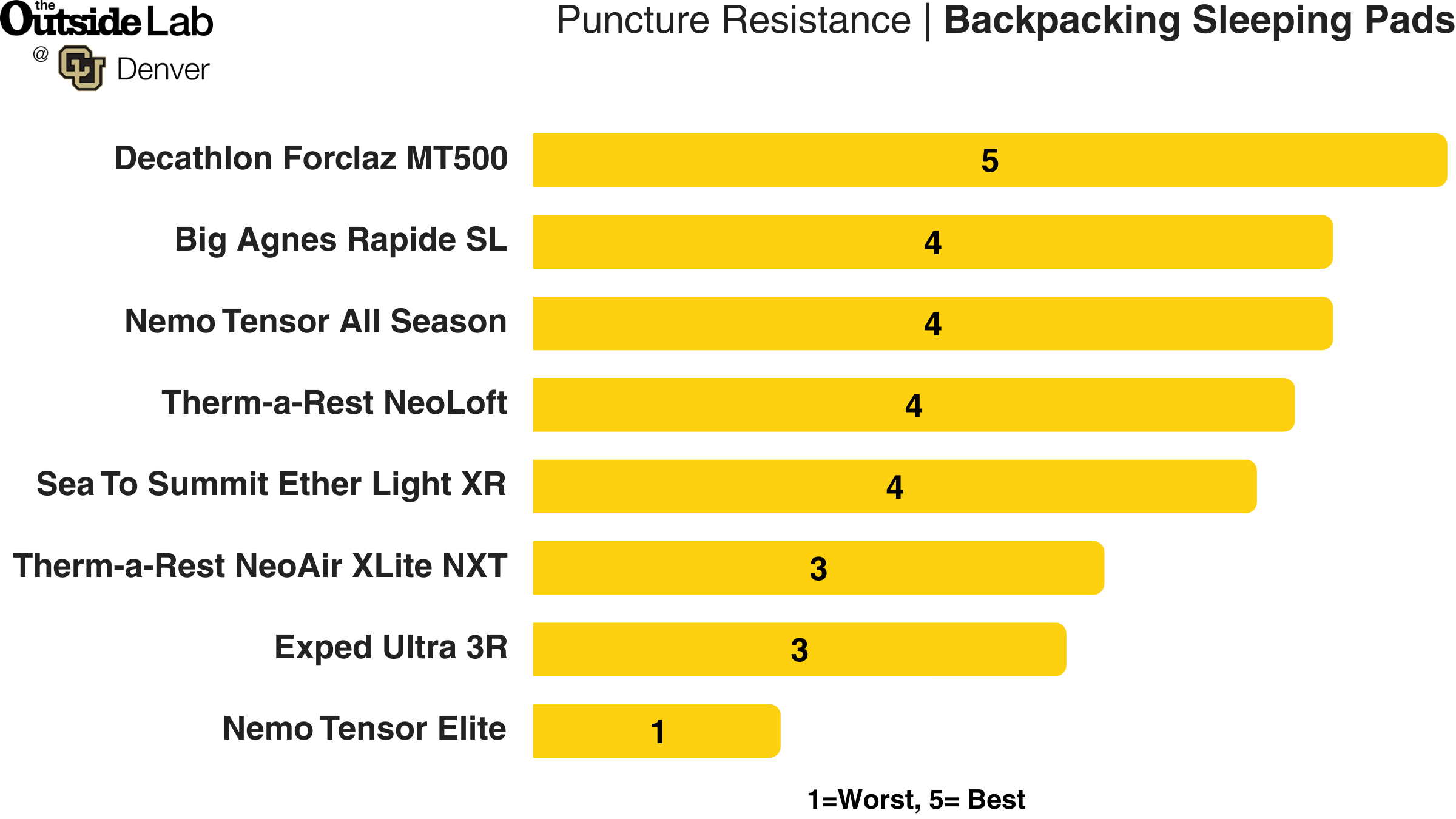
How We Test Sleeping Pads in the Outside Lab
Want to learn more about the Outside Lab at CU Denver? Check out our deep-dive.
Puncture Resistance
To evaluate the puncture resistance of backpacking sleeping pads in the Outside Lab, we tested how much force was needed to poke a hole in the pad fabric using six different needles. Needles varied in gauge (thickness) and tip type: Three needles had a sharp point and three had a blunt (rounded) tip. A universal test machine was used to press the needle, held at a 90-degree angle, into the pad at a controlled rate of 1 millimeter per second (1 mm/s), recording the force throughout the test. Each pad was inflated to 100-percent capacity (no more air could be added) for equal testing conditions. After each test, the pad was patched and re-inflated to full capacity for the next round.
Using a range of needles allowed us to better mimic outdoor scenarios and puncture culprits, with three needles standing in for sharp objects like splinters and cactus pines, and three needles standing in for pine needles and small sticks. No pad is puncture-proof, but if you are venturing into a particularly “pokey” area, it’s good to know if extra precautions are needed when bedding down for the night. A score of 1 to 5, worst to best, was given as an average of all tests combined.
Meet our Testers
Nathan Pipenberg is our category manager for backpacking sleeping pads, sleeping bags, and trekking poles. He’s also Backpacker’s ultralight columnist, a thru-hiker, a one-time trail builder and wildland firefighter, and enjoys making his own backpacking gear in his free time.
Camille Wood-Foucar is a wildland firefighter who elected to skip the 2024 season in favor of a Pacific Crest Trail thru-hike, the perfect testing ground for some of the most promising ultralight gear of the year.
Stephanie Pearson is a longtime Outside tester and contributor, and the former category manager for backpacking sleeping pads and sleeping bags. She has slept in a cave in Tasmania, in a tent at Mount Everest Base Camp, and under the stars while lost in the Australian Outback. She’s a fitful sleeper.